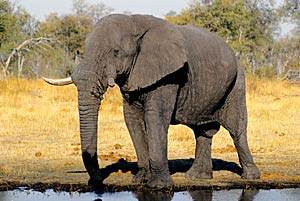|
Humans and Wildlife - finding a balance to a peaceful co-existence |
 As a result of the successful conservation efforts on elephants by government, NGOs and local communities, their populations have grown significantly over the past years. At the same time human population is increasing and the traditional range/migration routes of elephants are converted to farmland to feed the growing human population. As a result of the successful conservation efforts on elephants by government, NGOs and local communities, their populations have grown significantly over the past years. At the same time human population is increasing and the traditional range/migration routes of elephants are converted to farmland to feed the growing human population.
A recent discussion on DLIST focused on human elephant conflicts that have become of major concern in the Kunene Region, Namibia. This discussion drew a lot of interest from diverse sectors, as it raised concerns on the loss of human lives, crops and income caused by marauding elephants in this region. The high human and elephant populations have brought about competition for scarce water resources between subsistence farmers and elephant. Elephants raid agricultural lands, damage water installations and sometimes people lose their lives.
According to some studies these human elephant conflicts are a result of unplanned, unregulated and haphazard development. Therefore, among solutions to solve these problems are proper planning - planning that takes into consideration the needs of both humans and wildlife.
Among the measures villagers are calling for is the speedy erection of an electric fence which the government has been promising to erect for a long time, as well as compensating farmers who lost their crops. However, Dr Rob Little - Conservation Director at WWF-SA feels that, the idea of confining wildlife (elephants) is a complex issue. There are potential risks, including disease interchange between livestock and wildlife which are a real threat to the agricultural economy and indeed human health.
According to a report by the WWF the most effective way to manage human wildlife conflicts is to give rights over wildlife to local communities, thus enabling local communities to benefit from neighbouring wildlife through the establishment of conservancies. It is said that, the local communities will be able to generate more income from wildlife than they suffered from wildlife losses.
One DLISTer argued that in most cases the revenue collected from the trophy hunting of ‘problem’ elephants in the conservancies does not benefit the affected communities, and those whose crops were destroyed, as the money is usually shared with all the people in the conservancy or just put into the administration of the conservancy.
Most of the contributors to the DLIST discussion mentioned that communities around Southern Africa and elsewhere make use of chilli peppers to deter elephants from their farmlands (see following report). Apparently, elephants hate the smell of capsicum found in chillies. Some of the advantages of using chillies as an elephant deterrent include are that the villagers can generate some income from selling the chillies as a cash crop, or they can make some chilli jam or sauces for selling. It is also said that having bee hives around the fields can help deter elephants as they do not like the sound of bees. Traditional methods such as placing strings with bells around crops and banging drums to scare the elephants away are also used in conjunction with the chilli peppers. Some projects have gone to the extent of building special tailor-made “elephants only” drinking places away from household water-points.
This is hoped to reduce interaction between humans, livestock and elephants. Are these enduring solutions or they are just stop gap, short term measures that only address the symptoms of the problem rather than its causes?
Another interesting comment raised in the discussion forum centred on how elephants find ways to overcome these “solutions”. It takes only one clever elephant to work out how to avoid the chilli peppers, and as a result a field of crops can be lost. There are suggestions in some circles that “problem” elephant activity might be due to only certain individual elephants in the population, the so-called “habitual” problem elephants most thought of as being male elephants. It may not be easy to identify the “problem” elephants considering that most of the raids on crop fields occur at night.
Can elephants co-exist with humans? These issues that started as a discussion on the DLIST discussion forum have presently been taken further. A local radio station in the Kunene Region of Namibia that engages with communities has undertaken to further examine these problems and solutions with the communities input. Keep an eye on DLIST for further development.
|